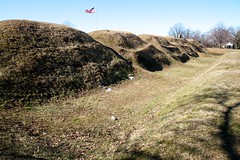
‘The Confederate Advance’
courtesy of ‘Rob Shenk’
Let’s go back 150 years. DC, or the Federal City if you will, is under siege; and not that happy go lucky, Steven Seagal Under Siege. An up-start new country materializes across the Potomac; and the newly elected president, one Abraham Lincoln, isn’t going to let them leave the Union without a fight. This disagreement quickly escalates into the American Civil War. There’s a quick, but brutal, battle at a place called Bull Run. Not much else happened in 1861, except for the Battle of Ball’s Bluff.
Wait, we don’t have to imagine what happened at Ball’s Bluff. Rob Shenk beautifully captures the reenactment. Looking at his pictures, wonderfully smoke filled that they are, takes you back to October 21st 1861. Musket flashes; a rainbow of woolen uniforms; the Stars and Stripes and the Stars and Bars competing for the field. It is as if you could hear the Rebel Yell and the Battle Hymn of the Republic on the wind. Simply put: excellent photographs.



